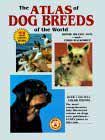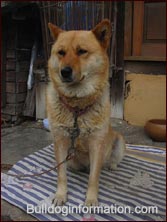Korean Jindo
(Jindo Gae, Jindo dog, Chindo gae, Chindo Dog)
Introduction
The Jindo is an agile, spitz-type hunting dog breed from the island of Jindo, Korea. This remarkable hunting dog was designated as a National Treasure by the Korean government in 1938. It is one of the three native breeds of Korea, together with the Sapsari and Pungsan.
Korean Jindo "Stewart"
Photo by Swsetiadi
Origin
It is not known how the first northern-type dogs arrived to Korea, but the Korean Jindo descends from these dogs that were present on the island of Jindo, south west of mainland Korea.
There are several stories and legends surrounding the history of the Jindo dog, but no written records exist to support any one of them.
A first story tells that at the time of the Chinese Sung Dynasty (960-1279), a Chinese cargo ship had a shipwreck off the seacoast of Jindo island.
The dogs on board the ship swam ashore to Jindo, and Korea's indigenous dogs are the direct descendents of these dogs.
.
.
.
.
The Canine Information Library 2003-2008 © All rights reserved. Photos © John No, Gina Smith, Hannah Bae, Swsetiadi and Joel Burslem. No part of bulldoginformation.com may be copied, distributed, printed or reproduced on another website without the owner's written permission.
Appearance
The Korean Jindo has a typical spitz-type conformation: a strong, compact body, prick ears and a tail curled over the back of the body.
The fur is dense and soft. Admitted colors are red (fawn) and white. However, black-and white and grey are also occasionally seen.
Temperament
The Korean Jindo is a typical spitz-type dog, protective of his family and aloof with strangers. It is agile like a cat, courageous, proud and independent, sometimes to the point of being stubborn.
In traditional Korean hunting without guns, gun dogs or retrievers would be useless. Jindoes are independent thinkers and workers, a trait appreciated by Korean hunters.
Unlike most other hunting dogs, Jindoes manage to go hunting on their own, but they will always try to carry back home the game they have killed. If the prey is too big to carry, it will return to fetch his master and lead him to the place of the kill. If Jindoes hunt in pack, only one dog will return home, while the others will guard the game.
Jindos are said to possess a remarkable homing ability, and to be capable of finding their way back home over very long distances. This ability is probably linked to their incredible scent. They are said to recognize and remember over 30,000 different scents. This explains why Jindos are utilized by the South Korean military on their military bases where they learn to recognize thousands of members of personnel and identify outsiders among them.
Jindoes are extremely clean and easy to housetrain. In fact they will never excretes in the house and is so clean that after excreting, it will use its paws to cover the mess with dirt.
This breed is not a dog for everyone. Jindoes have a strong sense of hierarchy and need an owner who can keep his alpha-position. They will also try to challenge other the other pets in the household. In this case they may appear aggressive or quarrelsome, but once they has established their position (at the top) they will leave the other dogs alone.
Further reading:
- Jin Dog Gae by Woo Mu Jong. Korean National Dog Association, 1996. Comprehensive breed description, richly illustrated. In Korean.
- Hankookea Gae by Ha Jee Hong. 2003. Introduction to several traditional Korean dogs, including the Sapsaree (a non-spitz Korean breed), Jindo and the Poongsan. In Korean.
- Tanabe Y, 1991. The origin of Japanese dogs and their association with Japanese people. Zool Sci (Tokyo) 8:639-651.
- Ha JH and Kim KS, 1998. The origin of Korean native dogs. Korean J Anim Sci 40:701-710.
- "Genetic variability in East Asian dogs using microsatellite loci analysis" by KS Kim, Y Tanabe, CK Park, and JH Ha. In: Journal of Heredity, September-October 2001, volume 92, p 398-403. DNA analysis was performed on 213 dogs of 11 breeds native to East Asia, including 21 Jindo dogs.
- The Canine Lexicon by Andrew de Prisco and James B. Johnson. TFH, 1993. Contains a brief section on the breed.
- Dogs, the ultimate Dictionary of over 1,000 dog breeds by Desmond Morris. Trafalgar square publishing, 2001. Contains a brief introduction to the Jindo.
- "Mitochondrial DNA polymorphism in Jindo Dogs" by F Umenishi, B Han and S Ikemoto. The Journal of Veterinary Medical Science, 1 April 1993, p 313-317. Analysis of mitochondrial DNA.
- The Jindo dog, by the Office of the President, Republic of Korea.
External links:
Jindoes rescue

The Atlas of Dog Breeds of the World
Books including a short section about the Koren Jindo:
Dogs: The Ultimate Dictionary of Over 1,000 Dog Breeds
by Desmond Morris
More information:
Another legend has it that during the Goryeo Dynasty (918-1392), the Mongolian Army came to the peninsula to suppress a rebellion and some of the military dogs were left behind, which have been raised to this day.
Still another version is that, at the beginning of the Joseon Dynasty (1392-1910), Jindo dogs were imported from Mongolia to be guard dogs at the national ranch located in Jindo-gun, Mokchang-myeon (now Jisan-myeon). Others say that the Jindo dog is the descendant of dogs raised by the ancient people of Korea since the New Stone Age, and that the Jindo's genetic pool has never been diluted.
Unlike other dogs, there is a clear distinction between the female and male Jindo dog. The male dogs shoulder height is 48-53cm the body length is 53-58cm, and he is wild, imposing and brave. The females shoulder height is 40-50cm, the body length is 50-51cm and she is smart, swift, and graceful.
Three or four months after birth, the tail rolls up and when it is four to six months old, the ears stand upright. About this time the thick fur starts to take the place of the soft baby fur. The body takes form and specific characteristics start to show up. One such characteristic is the eyes, which aren't round and bulbous but sharp and triangle shaped. It is always bright and full of unpolished beauty.
White Korean dog outside a straw hut at Suwon Folk Village, South Korea. Photo by Gina Smith
Studies based on Mitochondrial DNA (mtDNA) polymorphism have indeed shown that the Jindo dog remained relativetly purebred, especially on the island of Jindo. The insular isolation and the strong current running between Jindo Island and the mainland, which made it difficult to cross the narrow strait, explain why the Jindo's genetic pool remained relatively pure throughout the centuries.
This came to an end in the 1970s when a bridge was built between the island of Jindo and the mainland.
Another study involving 11 Asian dogs (three Korean native dogs, a Kishu, a Shiba, an Akita, an Hokkaido, an Eskimo dog and 3 other Asian dogs) indicated that Korean native dogs form a closely related group, showing a close relationship between Korean native dogs and Eskimo dogs, which may reflect the migration of the Scythian people from central North Asia to East Asia in the prehistoric age. Some researchers (Ha and Kim 1998; Tanabe 1991) suggest that Korean native dogs originated from dogs in the northern part of Far East Asia. However, for that conclusion, the larger dog populations from central and northeast Asia, including China, Mongolia, and Siberia need to be examined.
Reversely, genetic studies have shown that Korean dogs brought to central Japan via the Korean Peninsula in the Yayoi and Kofun periods (300 B.c. - A.D. 650) had strong genetic impact on many Japanese native breeds (except the Hokkaido dog). The genetic variety of Japanese native dogs suggests that the dogs may consist of populations derived from several genetically different ancestral populations and their crossbreeds rather than from a single origin. We may therefore conclude that the Korean Jindo is genetically more ancient than the Japanese native dogs, except maybe, for the Hokkaido dog.
Today this day Korean dogs migrate to other parts of the world with Korean immigrants, but recently exporting dogs from Korea has become prohibited.
Korean Jindo "Stewart"
Photo by Swsetiadi











